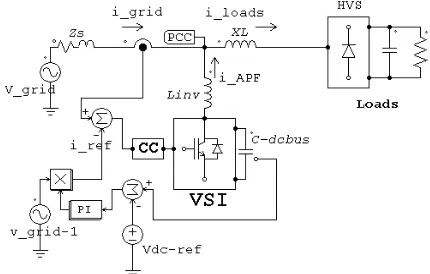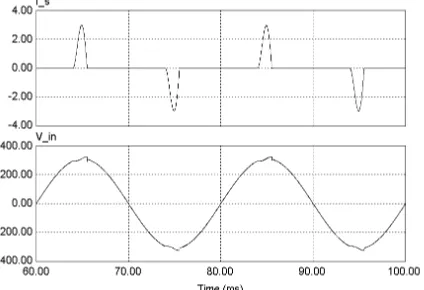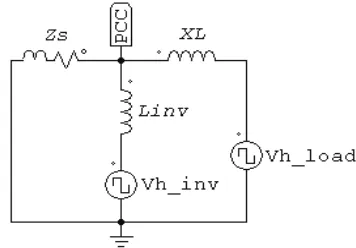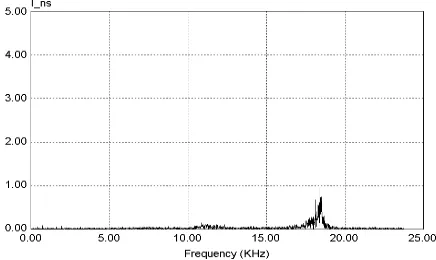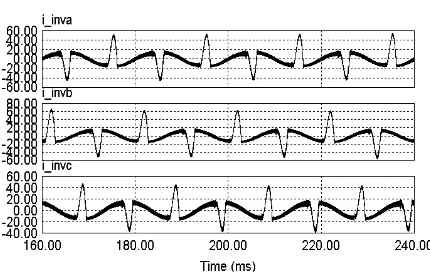Simulation of Active Filtering Applied to A Computer Centre
Julius Sentosa Setiadji
1, Hanny Hosiana Tumbelaka
1,21
Electrical Engineering Department, Faculty of Industrial Technology, Petra Christian University.
2
Center for Renewable Energy and Sustainable Technologies Australia (CRESTA), Curtin University of Technology, Western Australia.
e-mail: [email protected] , [email protected]
Abstract
In this paper, the implementation of a shunt active power filter with a small series reactor for a three-phase system is presented. The system consists of computer loads, which are harmonic voltage sources, with significant unbalanced components. The filter consists of a three-phase current-controlled voltage source inverter (CC-VSI) with a filter inductance at the AC output and a DC-bus capacitor. The CC-VSI is operated to directly control the AC grid current to be sinusoidal and in phase with the grid voltage. The simulation results indicate that the filter along with the series reactor is able to handle the harmonic voltage sources, as well as the unbalance, so that the grid currents are sinusoidal, in phase with the grid voltages and symmetrical.
Keywords: active power filter, harmonic distortion.
Abstrak
Dalam makalah ini dijelaskan tentang penggunaan filter aktif type paralel dengan menggunakan reaktor kecil yang dipasang secara seri untuk sistem tiga phasa. Jaringan sistem ini menggunakan komputer sebagai beban yang merupakan sumber harmonisa tegangan ; sekaligus menimbulkan ketidakseimbangan sistem. Filter daya aktif merupakan current-controlled voltage source inverter (CC-VSI) tiga phasa dengan sebuah filter induktansi pada keluaran AC dan sebuah kapasitor DC-bus. CC-VSI dioperasikan untuk mengendalikan secara langsung arus jala-jala AC menjadi sinusoidal dan sephasa dengan tegangan jala-jala. Hasil simulasi menunjukkan bahwa filter dengan reaktor seri mampu untuk mengatasi sumber harmonisa tegangan dan juga ketidakseimbangan beban sehingga gelombang arus menjadi sinusoidal, sephasa dengan tegangan jala-jala dan simetris
Katakunci: filter daya aktif, distorsi harmonik.
Introduction
Non-linear loads, especially power electronic loads, create harmonic currents and voltages in the power systems. For many years, various active power filters (APF) have been developed to suppress the harmonics, as well as compensate for reactive power, so that the utility grid will supply sinusoidal voltage and current with unity power factor [1]-[3].
Conventionally, the shunt type APF acts to eliminate the reactive power and harmonic currents produced by non-linear loads from the grid current by injecting compensating currents intended to result in sinusoidal grid current with unity power factor. This filter has been proven to be effective in compensating harmonic current sources, but it cannot properly compensate for harmonic voltage sources. Many electronic
Catatan: Diskusi untuk makalah ini diterima sebelum tanggal 1 November 2002. Diskusi yang layak muat akan diterbitkan pada Jurnal Teknik Elektro volume 3, nomor 1, Maret 2003.
appliances, such as switch mode power supplies and electronic ballasts, are harmonic voltage sources. A voltage sourcing series active power filter is suitable for controlling harmonic voltage sources, but it cannot properly compensate for harmonic current sources [4].
Figure 1. Active Power Filter Configuration
investigated to handle the harmonic problems as well as load unbalance generated from a computer centre (see Figure 1).
Harmonic Voltage Source
Power supplies of computers are voltage type of harmonic source. The AC/DC conversion block basically consists of a diode rectifier with smoothing DC capacitors. Although the current is highly distorted, its harmonic amplitude is significantly affected by the impedance of the AC side. On the other hand, the voltage at the rectifier input terminal is characteristic and less dependent upon the AC impedance [4]. Therefore, a diode rectifier behaves like a voltage source. Figure 2 shows the typical current and voltage waveforms at the AC side. The distorted voltage causes harmonics in the grid current.
Figure 2. Typical current and voltage (ph-n) waveforms at the AC side due to a
computer-type load
Shunt Active Power Filter Operation
The three-phase shunt active power filter is a three-phase current controlled “voltage-source inverter” (CC-VSI) with a mid-point earthed, split capacitor in the DC bus and inductors in the AC output (It is essentially three independent single phase inverters with a common DC bus).
Conventionally, a shunt APF is controlled in such a way as to inject harmonic and reactive compensation currents based on calculated reference currents. The injected currents are meant to “cancel” the harmonic and reactive currents drawn by the non-linear loads. However, the reference or desired current to be injected must be determined by extensive calculations
with inherent delays, errors and slow transient response.
1. Direct Control of the Grid Current
In this scheme (see Figure 1), the CC-VSI is operated to directly control the AC grid current rather than its own current [5] [6]. The grid current is sensed and directly controlled to follow symmetrical sinusoidal reference signal, which is in phase with the grid voltage. Then, the PWM signal to drive the inverter is obtained from regulating the error signal, which is the difference between the actual current and the reference signal, by using a current controller (CC). Hence, by putting the current sensors on the grid side, the grid current is forced to behave as a sinusoidal current source and the grid appears as a high-impedance circuit for harmonics. By forcing the grid current to be sinusoidal, the APF automatically provides the harmonic, reactive, negative and zero sequence currents for the load, following the basic current summation rule:
igrid = iAPF + i loads (1)
The sinusoidal grid current reference signal is given by:
iref = k vgrid-1 (2)
where vgrid-1 is the fundamental component of the
grid voltage, and k is obtained from an outer control loop regulating the CC-VSI DC-bus voltage. This can be accomplished by a simple PI control loop. This is an effective way of determining the required magnitude of active current required, since any mismatch between the required load active current and that being forced by the CC-VSI would result in the necessary corrections to regulate the DC-bus voltage. In the VSI topology used in the APF, the DC-capacitor voltage must be greater than the peak of the AC grid voltage.
2. Series Inductance
A key component of this system is the added series inductance XL (see Figure 3), which is
comparable in size to the effective grid impedance, ZS [6]. Without this inductance (or a
voltage at the loads. Therefore, there are still harmonic voltages across the grid impedance, which continue to produce harmonic currents. With XL, the Vh_load can appear across XL. If the
CC-VSI can control grid currents to have no harmonics, CC-VSI harmonic voltages (Vh_inv)
are produced which mirror Vh_load. The
inductance XL takes the place of a series active
power filter at significantly less cost, providing the required voltage decoupling between load harmonic voltage sources and the grid.
Figure 3. Circuit equivalent for harmonics
There are several ways to determine the size of
XL [4], [7]. In [4], it is suggested that the
minimum value of XL is 6%. In [7], the XL is used
for a different purpose and not related to harmonic voltage type loads.
The practical choice of XL is that it should be as
small as possible to minimize cost. Furthermore, if the APF can directly force the grid current to be sinusoidal, the voltage at the PCC will have similar characteristics to the grid (except very small fundamental voltage drop and very small phase shift). In order to make the loads operate in the similar operating point to which they were connected directly to the grid, then the size of XL
should be chosen close to ZS ≈ XS in per-unit
value (usually the resistance of the grid impedance is very small compared to its inductance).
As mentioned, in this application, the CC-VSI is switched so as to regulate the grid current rather than its own current. Controllability is ensured by the proper relative sizing of the inverter filter inductance Linv and the choice of the DC bus
voltage so that the two output PWM states (per phase) will always result a corresponding opposite polarity current error signal slopes. The controllability of the AC grid current is guaranteed since the CC-VSI can be constructed so that its minimum di/dt exceeds the maximum
di/dt permitted by the inductance XL. This
provides the CC-VSI complete control over the AC grid current.
A Three-Phase Shunt Active Power Filter
With Computer Loads
By directly controlling the grid current, a three-phase shunt APF can be provided for all non-linear loads at the PCC (or at a distribution board) instead of compensating each load (computer) individually. The system is simpler and more efficient because only one current sensor for each phase is located in the grid side. Furthermore, it is practical to provide a series reactor for total loads. The reactor is installed at the PCC and integrated with the APF. The capacity can be chosen for the possible maximum power of harmonic voltage sources.
A three-phase shunt APF has been proven for balanced loads [5]. However, the system contains significant amounts of load unbalance since a computer centre contains predominantly computers as non-linear single-phase loads. Such loads produce large harmonic and negative sequence currents. Hence, the filter has to inject the inverse of the negative sequence current to balance the unbalanced loads. The shunt APF discussed previously has the ability to balance the asymmetrical current. This is because the CC-VSI is operated to directly control the AC grid current to follow a three-phase balanced sinusoidal reference signal without measuring and determining the negative sequence component. Once the grid currents are able to follow the reference signal, the inverter creates the inverse of the negative sequence (as well as zero sequence) currents automatically. At the PCC, all three currents according to (1) are potentially accessible to be directly controlled by the CC-VSI.
vector sum of the triplen harmonic currents from each phase as depicted in the harmonic spectrum of the neutral current.
Figure 4. Load currents (phase A, B and C) and neutral current
Figure 5. The spectrum of load current (phase A) and neutral current
Figure 6. Grid voltage, load current and grid current
In Figure 6, the shunt active power filter combined with the series reactor is able to successfully compensate the total loads that produce harmonic and unbalanced currents. The grid currents become sinusoidal and in phase with the grid voltages (in this graph, only phase
A of the grid voltages is shown). The magnitude is determined by the active power required by the system. The remained problem is high-switching-frequency ripple that is simple to eliminate using a small high-pass filter.
Furthermore, the grid currents are symmetrical in magnitude and phase (figure 7). These currents are balanced because the CC-VSI is able to generate three different currents for each phase. For each phase, the current controller is able to force the average current error, which is the difference between the reference signal and the actual current to be zero. Then, the individual phase current can follow its reference signal closely. By doing so, the neutral current is also eliminated, which the spectrum is depicted in figure 8, except high-switching-frequency current ripple due to PWM switching action.
Figure 7. Grid currents (phase A, B and C) and neutral current after compensation
Figure 8. The spectrum of neutral current after compensation
Hence, the inverter not only generates harmonics to eliminate the load harmonics but also provide balancing to create the symmetrical grid currents and mitigating the neutral current.
Figure 9. Filter/inverter output currents (phase A, B and C)
Conclusion
This paper proposes the implementation of a three-phase active power filter together with a decoupling reactor in series with the load operated to directly control the AC grid current to be sinusoidal and in phase with the grid voltage. From the simulation results, this system mitigates the neutral current and provides unity power factor operation of non-linear loads with harmonic voltage sources and unbalanced components.
References
[1] M. El-Habrouk, M.K. Darwish and P. Mehta, Active Power Filter: A Review, IEE Proc. Electr.Power.Appl, pp. 403-413, Sept 2000
[2] B. Singh, K. Al-Haddad and A. Chandra, A Review of Active Filter for Power Quality Improvements, IEEE Trans. on Industrial Electronics, pp. 960-971, Feb 1999
[3] Fang Zheng Peng, Harmonic Sources and Filtering Approaches, IEEE Industry Appli-cations Magazine, pp. 18-25, July 2001 [4] Fang Zheng Peng, Application issues of
Active Power Filters, IEEE Industry Applications Magazine, pp. 21-30, Sept 1998
[5] H.L. Jou, Performance Comparison of the Three-phase Active-power-filter Algo-rithms, IEE Proc. Gener. Trans. Distrib., pp. 646-652, Nov 1995
[6] Tumbelaka, H.H., L.J. Borle, and C.V. Nayar, Application of A Shunt Active
Power Filter to Compensate Multiple Non-linear Loads, in Australasian Universities Power Engineering Conference (AUPEC). 2002. Melbourne, Australia.
